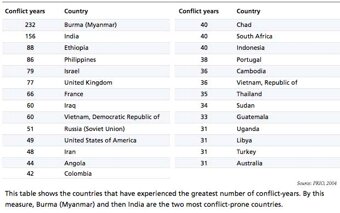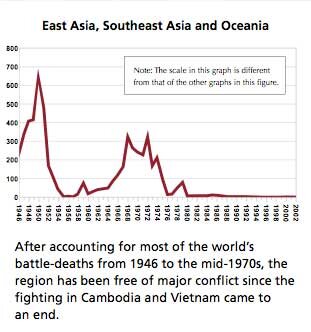No, China has not yet decided to dump its Treasury bonds… but give it time.
AsiaPundit closely tracks both the Chinese currency and the US dollar. However, we don’t pay nearly as much attention to global prices for base metals. As such, we are a bit late in bringing you details of a global currency meltdown that is so severe that the United States is passing new capital control measures.:
WASHINGTON — People who melt pennies or nickels to profit from the jump in metals prices could face jail time and pay thousands of dollars in fines, according to new rules out Thursday.
Soaring metals prices mean that the value of the metal in pennies and nickels exceeds the face value of the coins. Based on current metals prices, the value of the metal in a nickel is now 6.99 cents, while the penny’s metal is worth 1.12 cents, according to the U.S. Mint.
…
Under the new rules, it is illegal to melt pennies and nickels. It is also illegal to export the coins for melting. Travelers may legally carry up to $5 in 1- and 5-cent coins out of the USA or ship $100 of the coins abroad “for legitimate coinage and numismatic purposes.”
For those who, like ourselves, are deficient in mathematics that means that a US nickel is worth almost 40 percent more melted down than it based on its denomination. Chinese demand for base metals is generally cited as a prime reason for rising prices.
And it is not just the US. This is indeed a global currency meltdown. As this 2003 article notes China has been seeking European coins for melting. Within Asia, there is massive smuggling of the Philippine peso to buyers in China.:
MANILA : With a face value of less than two US cents the humble Philippine one peso coin may be worth next to nothing at home but in metal-hungry China it spells big bucks.So much so that smuggling of the coins has become something of a growth industry in the Philippines and a major headache for the central bank.
According to local media reports, the coins are sold in China for 1,000 pesos (US$20) per kilogramme and the metal derived from melting them down is used in the manufacture of electronics goods like mobile phones.
 As we have not heard any reports of the melting of the Chinese yuan, we assume that either the nickel-plated steel material is worth more in coin rather than base-metal form or that owners of blast furnaces in China are betting on further appreciation of the local currency.
As we have not heard any reports of the melting of the Chinese yuan, we assume that either the nickel-plated steel material is worth more in coin rather than base-metal form or that owners of blast furnaces in China are betting on further appreciation of the local currency.
However, if anyone knows differently please comment — AP may yet consider requesting that our employer pay us in coins.
Technorati Tags: asia, china, east asia, economy, northeast asia, philippines, money, southeast asia


 A Reader’s Digest survey conducted in 35 various cities across the globe analysed and tested the politeness and helpfulness of people in each urban centre. More than 2000 separate tests of behaviour were conducted to try and find the world’s most courteous place….
A Reader’s Digest survey conducted in 35 various cities across the globe analysed and tested the politeness and helpfulness of people in each urban centre. More than 2000 separate tests of behaviour were conducted to try and find the world’s most courteous place…. They are the handiwork of the lukayo, women way past their sexual prime who dance at weddings where they wave the phalluses like trophies, brandish them like swords, twirl them like batons, or thrust them like, well, phalluses.
They are the handiwork of the lukayo, women way past their sexual prime who dance at weddings where they wave the phalluses like trophies, brandish them like swords, twirl them like batons, or thrust them like, well, phalluses. MANILA (Reuters) - Bus drivers negotiating the sweltering streets of Manila have a new thing to stress about — their armpits.
MANILA (Reuters) - Bus drivers negotiating the sweltering streets of Manila have a new thing to stress about — their armpits. Journalists assigned to the palace wearing jeans, trendy shirts and non-leather footwear is now common sight around Malacanang, specifically inside the Kalayaan Hall Press Working Area (PWA).
Journalists assigned to the palace wearing jeans, trendy shirts and non-leather footwear is now common sight around Malacanang, specifically inside the Kalayaan Hall Press Working Area (PWA).


 I Gloria Macapagal-Arroyo, President of the Republic of the Philippines and Commander-in-Chief of the Armed Forces of the Philippines, by virtue of the powers vested upon me by Section 18, Article 7 of the Philippine Constitution which states that: “ The President…whenever it becomes necessary,…may call out (the) armed forces to prevent or suppress…rebellion…, “ and in my capacity as their Commander-in-Chief, do hereby command the Armed Forces of the Philippines, to maintain law and order throughout the Philippines, prevent or suppress all forms of lawless violence as well any act of insurrection or rebellion and to enforce obedience to all the laws and to all decrees, orders and regulations promulgated by me personally or upon my direction; and as provided in Section 17, Article 12 of the Constitution do hereby declare a State of National Emergency.
I Gloria Macapagal-Arroyo, President of the Republic of the Philippines and Commander-in-Chief of the Armed Forces of the Philippines, by virtue of the powers vested upon me by Section 18, Article 7 of the Philippine Constitution which states that: “ The President…whenever it becomes necessary,…may call out (the) armed forces to prevent or suppress…rebellion…, “ and in my capacity as their Commander-in-Chief, do hereby command the Armed Forces of the Philippines, to maintain law and order throughout the Philippines, prevent or suppress all forms of lawless violence as well any act of insurrection or rebellion and to enforce obedience to all the laws and to all decrees, orders and regulations promulgated by me personally or upon my direction; and as provided in Section 17, Article 12 of the Constitution do hereby declare a State of National Emergency.

 Though Mao Tse-tung’s portrait still hangs in Tiananmen Square, a recent poll shows that the Chinese are crazier about capitalism than are Americans. In fact, they top the world-wide rankings in their zeal for free markets. No wonder Mao isn’t smiling.
Though Mao Tse-tung’s portrait still hangs in Tiananmen Square, a recent poll shows that the Chinese are crazier about capitalism than are Americans. In fact, they top the world-wide rankings in their zeal for free markets. No wonder Mao isn’t smiling.
 Sol Vanzi joins us — she lives on the same floor. She informally handles Imelda’s relations with local and international media. She runs a website that collates Philippine news: http://www.newsflash.org. She’s 61, she tells us, and she immediately sits down, opens a beer and launches into a tirade during which she disputes all the conventional wisdom about the Marcos regime and Imelda. She just naturally assumes (rightly, I suspect) that she’s not addressing a group of loyalists.
Sol Vanzi joins us — she lives on the same floor. She informally handles Imelda’s relations with local and international media. She runs a website that collates Philippine news: http://www.newsflash.org. She’s 61, she tells us, and she immediately sits down, opens a beer and launches into a tirade during which she disputes all the conventional wisdom about the Marcos regime and Imelda. She just naturally assumes (rightly, I suspect) that she’s not addressing a group of loyalists. The Philippines was second only to Iraq as the most dangerous place for journalists in 2005, two international media watchdogs, the New York-based Committee to Protect Journalists (CPJ) and the Paris-based Reporters Sans Frontieres (RSF), said today.
The Philippines was second only to Iraq as the most dangerous place for journalists in 2005, two international media watchdogs, the New York-based Committee to Protect Journalists (CPJ) and the Paris-based Reporters Sans Frontieres (RSF), said today.



 7. Freedom of movement of people and goods shall be guaranteed except
7. Freedom of movement of people and goods shall be guaranteed except

































